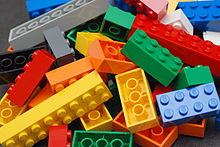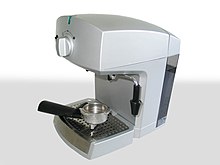Acrylonitrile-butadiene-styrene copolymer
| Structural formula | |||||||
|---|---|---|---|---|---|---|---|

|
|||||||
| Typical section from the ABS graft copolymer | |||||||
| General | |||||||
| Surname | Acrylonitrile butadiene styrene | ||||||
| other names |
|
||||||
| CAS number | 9003-56-9 | ||||||
| Monomers / partial structures | Acrylonitrile, butadiene and styrene | ||||||
| Type of polymer |
Copolymer |
||||||
| properties | |||||||
| Physical state |
firmly |
||||||
| hardness |
70-80 Shore D hardness |
||||||
| solubility |
|
||||||
| safety instructions | |||||||
|
|||||||
| As far as possible and customary, SI units are used. Unless otherwise noted, the data given apply to standard conditions . | |||||||
Acrylonitrile-butadiene-styrene copolymers ( abbreviation ABS ) are thermoplastic terpolymers in which a polybutadiene -based main chain covalently side chains of styrene-acrylonitrile copolymer (SAN) are connected. Since the two components are not soluble in one another, a micro-phase separation occurs, which increases the impact strength of the material due to the embedded, soft polybutadiene particles in the continuous, brittle SAN main phase.
The proportions of the monomers used vary in the range of 5-30% butadiene, as well as 15-35% acrylonitrile and 40-60% styrene.
ABS plastics
The ISO standard ISO 472: 2013 (de) describes acrylonitrile-butadiene-styrene plastic as a plastic made from terpolymers and / or mixtures of polymers and copolymers made from acrylonitrile, butadiene and styrene.
As an engineering plastic, ABS very often consists of a blend of the terpolymer with the pure hard component SAN, as this significantly reduces the average molecular weight and thus improves processability with the same hard / soft phase proportion and the same molecular weight of the PB soft phase. The material then consists of a PB core and the dissolved graft shell and SAN matrix.
Variants in which nitrile rubber (poly (butadiene-stat-acrylonitrile)) or SBR (poly (styrene-co-butadiene)) is used instead of a pure PB main chain are also known. The (partial) use of methyl styrene instead of styrene increases the temperature resistance of the material (higher glass transition point of the (M) SAN phase), as does the copolymerization of styrene with maleic anhydride. Transparent variants are obtained if the refractive index of the hard phase is matched to that of the PB soft phase by copolymerization with methyl methacrylate. For better environmental stability, the UV- and ozone-sensitive PB can be replaced by EPDM .
Manufacturing
ABS is produced on an industrial scale by graft copolymerization . In the case of ABS produced by graft copolymerization, a distinction is made between the emulsion and the mass process:
- Emulsion process
- Polybutadiene is made by emulsion polymerization and grafted with the other monomers. The product is dried and mixed with poly (styrene-co-acrylonitrile) while hot. Since high molecular weights are typically present in emulsion polymerization, the soft phases of the polymer formed in this process are particularly large.
- Mass procedure
- Here, too, polybutadiene is already present, which is dissolved in a reaction solution with acrylonitrile and styrene monomers. This reaction solution is then polymerized to the graft copolymer in a "graft-from" manner. It is a bulk polymerization . However, the product of this polymerization is not a "pure" graft copolymer, but a blend polymer is formed . This is due to the fact that polybutadiene does not dissolve in the poly (styrene-co-acrylonitrile) formed during the polymerization, but only in the monomer mixture. Residual polybutadiene therefore does not precipitate, but is stored in the product of the polymerization. One speaks of a soft phase (polybutadiene) which is embedded in a styrene-acrylonitrile matrix.
properties
In its raw form, ABS is a colorless to gray solid. It can be glued with methyl ethyl ketone (MEK) and dichloromethane (methylene chloride).
Further properties are:
- Elongation at break (DIN 53455): 15 to 30%
- linear expansion coefficient: 60–110 K −1 · 10 −6
- spec. Heat capacity: 1.3 kJ kg −1 K −1
- Continuous use temperature: max. 85 to 100 ° C
- electrical breakdown strength up to 120 kV · mm -1
- Resistance to oils and fats
- temperature resistant
- Resistance to weather conditions and aging
use
Household and consumer products dominate the global demand for acrylonitrile butadiene styrene. Well over 50% of ABS production in Western Europe is used by the automotive and electrical industries. ABS is well suited for coating with metals ( electroplating ) and polymers . This makes it possible, for example, to obtain a chrome-plated surface on a plastic part. Examples for the use of ABS are thermoformed parts made of sheets and films, automotive and electronics parts, motorcycle helmets, toys (e.g., LEGO building blocks or Play mobile -Figuren), housings of electrical appliances and computers, edge bands ( edge band ) in the furniture industry, consumer goods with Increased demands on the impact resistance , musical instruments (for example clarinet and saxophone mouthpieces, ukulele bodies or edging of guitars) and the sidewalls of skis and snowboards made in sandwich construction . ABS is also used as a filament for the Fused Deposition Modeling 3D printing process and is particularly suitable for the production of prototypes thanks to its high stability and various post-processing options (grinding, painting, gluing, filler). Special forms of ABS filaments are ABS-ESD (electrostatic discharge) and ABS-FR (fire resistant), which are used in particular for the production of electrostatically sensitive components and fireproof finished parts.
processing
Standard ABS soften by 95–110 ° C (see Vicat softening temperature ). Typical processing temperatures in the injection molding process or in general by extrusion are in the range of 220-250 ° C (high-temperature ABS blends even higher). As a special form of the latter method, ABS is also a common material for 3D printers .
After pretreatment it is ideal for electroplating , painting and printing. Hot gas, heating element, rotational friction welding as well as ultrasonic and high frequency welding are possible.
recycling

If separated properly, ABS can easily be melted down and reused. Mechanical processes are available for sorting, which can separate it from common waste mixtures to a degree of purity of over 99%.
Norms
- DIN EN ISO 2580-1 Plastics - Acrylonitrile-butadiene-styrene (ABS) molding compounds - Part 1: Designation system and basis for specifications (ISO 2580-1: 2002). German version EN ISO 2580-1: 2002.
- DIN EN ISO 2580-2 Plastics - Acrylonitrile-butadiene-styrene (ABS) molding compounds - Part 2: Production of test specimens and determination of properties (ISO 2580-2: 2003). German version EN ISO 2580-2: 2003.
Trade names
|
|
Similar plastics
swell
- ↑ Wolfgang Kaiser: Kunststoffchemie für Ingenieure: from synthesis to application , 3rd edition, Hanser-Verlag, Munich 2011, p. 311, ISBN 978-3-446-43049-5 .
- ↑ Shore hardness at polymerservice-merseburg.de
- ↑ a b ABS data sheet ( memento of February 27, 2012 in the Internet Archive ) at unicgroup.com (PDF; 157 kB), accessed on June 11, 2013.
- ↑ a b Datasheet Poly (acrylonitrile-co-butadiene-co-styrene), acrylonitrile ~ 40 wt.%, Powder from Sigma-Aldrich , accessed on December 27, 2012 ( PDF ).
- ↑ ISO standard ISO 472: 2013 (de)
- ↑ a b Andreas Chrisochoou and Daniel Dufour, Styrenic Copolymers , Rapra Review Reports Vol. 13, 11 , ISBN 1-85957-363-0 [1]
- ^ Karlheinz Biederbick: Kunststoffe, 4th edition, Vogel-Verlag, Würzburg, 1977, p. 87, ISBN 3-8023-0010-6 .
- ↑ Sebastian Koltzenburg, Michael Maskos, Oskar Nuyken: Polymers: Synthesis, Properties and Applications . 1st edition. Springer Spectrum, Heidelberg 2014, ISBN 978-3-642-34772-6 , p. 416 .
- ↑ Sebastian Koltzenburg, Michael Maskos, Oskar Nuyken: Polymers: Synthesis, Properties and Applications . 1st edition. Springer Spectrum, Heidelberg 2014, ISBN 978-3-642-34772-6 , p. 415 .
- ↑ a b Christian Bonten: Plastics Technology Introduction and Basics , Hanser Verlag, 2014.
- ↑ Technical plastics market study, Ceresana, Sep. 2013 .
- ↑ Jochen Bettzieche: Playmobil without petroleum. In: nzz.ch. July 17, 2012, accessed January 14, 2019 .
- ↑ 3D printing: current application examples. February 15, 2016, accessed April 30, 2019 .
- ^ Argonne National Laboratory: Process for Recovering Usable Plastics from Mixed Plastic Waste ( Memento of March 15, 2012 in the Internet Archive ).


